Content |
The Canon Speedlite 580EX II flashgun is a professional quality device. It is solid and sturdy. Quality of the materials is very good. The unit is weather sealed, which adds to the appeal as well. The unit is huge. It's quite of a load in one's gear bag and it does take space. It weights over a pound with the "AA" batteries installed. But that is probably well worth the performance Canon 580EX II provides.
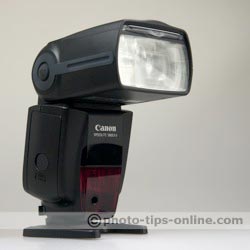 |
 |
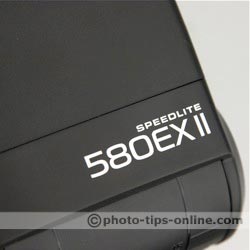 |
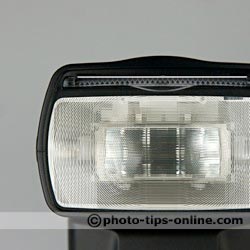 |
The flash head moves smoothly and locks tight at every angle. It tilts from -7 to 90 degrees and goes 180 degrees to the left and the right. That is convenient comparing to some other brands and older models that turn 180 degrees only in one direction and 90 or 120 degrees in the other one. This lack of additional angle can be very annoying: imagine yourself trying to set the head up for the back wall bounce and half of the times you cannot do it on the first try just because "the damn thing" won't turn 180 degrees.
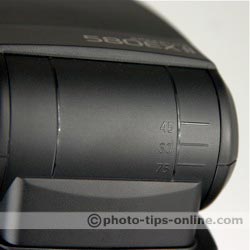 |
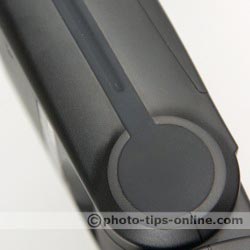 |
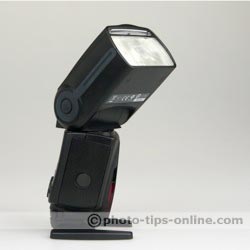 |
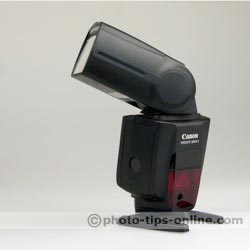 |
Surely enough for the unit of this class the head features a built-in wide-angle diffuser and a white reflector card. The white card can be pulled out by the diffuser only and not by itself. Looks like flash designers believe that the most common way to use the reflector card is the one with the wide angle diffuser pulled out (that way more light goes into the reflector card). But there are situations when you what to use the wide-angle diffuser or the reflector card alone and then you have to push one of them back in. It seems to us than an option to pull them separately would be nice and it does not look like something hard to design or build. However, it's not a major issue of course.
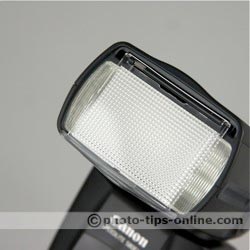 |
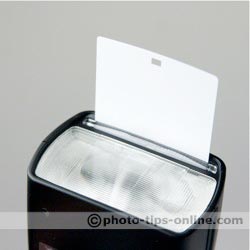 |
The buttons' tactile feeling is good. Not great, but good. It's hard to say what is "wrong" with the buttons. May be it is the flatness. Or may be it is their size. Sure, the space is limited and Canon folks probably did their best working on shape and size of the buttons. So, once again, the buttons are well designed but there is room for improvements.
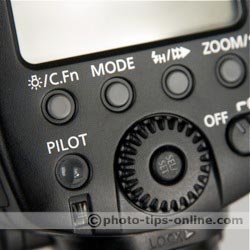 |
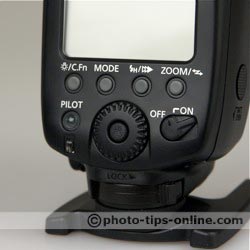 |
The select dial is simply ingenious. The same goes for the select dials on Canon professional SLR camera bodies (like Canon 40D, Canon 1D, etc.). It's so simple and so ergonomic. To our taste the dial on Canon Speedlite 580EX II is a bit hard to rotate. And if they could make it even bigger that wouldn't hurt either.
As we mentioned in our "Canon Speedlite 580EX vs. Canon Speedlite 580EX II review" the Mark II unit doesn't have a dedicated master/slave switch. Instead you have to press and hold the "Zoom" button for about 2 seconds. First of all, some people find these 2 seconds to be a long time to do the job and prefer the switch that was available on the Canon 580EX (Mark I). Secondly, unless you read the manual or ask someone there is no clue how to switch between master and slave wireless modes. Well, actually there is an icon next the "zoom" word that used as a symbol for wireless mode but in reality it doesn't help that much.
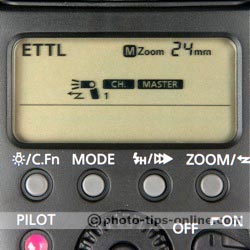 |
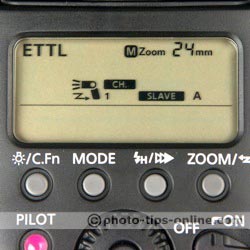 |
The mounting foot has a lever lock instead of traditional knurled nut and features a metal platform. The lever lock is a huge improvement. Now it is very fast and easy to attach Canon 580EX II flash to a camera or a stand. And since the platform is metal it does not wear as the plastic ones do.
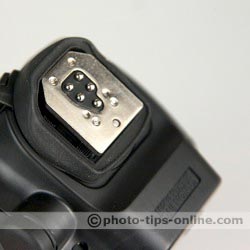 |
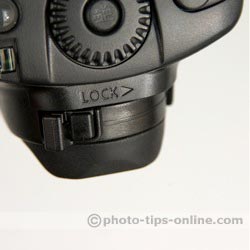 |
The battery compartment door is weather sealed as the rest of the unit. It opens by a spring, which is nice, and features a lock that locks automatically when the door is closed. To open the battery compartment door you have to slide the lock button to the left and then slide the door itself down. This design is not bad but required pressing on the door rather hard, which is not very comfortable. Canon still has to work on this one.
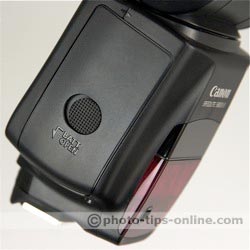 |
The auto focus assist beam shows very good performance. The assist beam produces not just a spot on the object but several parallel lines, which allows better focusing.
The external metering sensor allows the flash calculating its own light output without relying on the camera measurements. The flash has to know camera settings (ISO, shutter speed, aperture) to calculate the correct amount of light. These setting are sent to the flash automatically in the external auto mode but that only works with compatible camera bodies like Canon 1Ds Mark III. Otherwise the external metering has to be set to manual mode and all the camera setting must be entered into the flash manually.
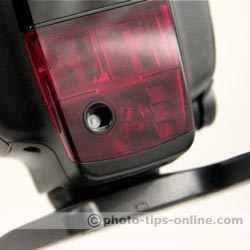 |
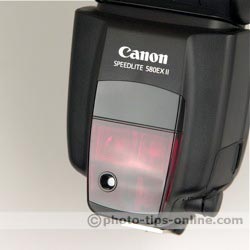 |
The performance of the external meter is far from great. The shots come out severely underexposed. And to enable external metering you have to use Custom Function 5 (for manual external metering mode set it to 3). Though there are few things we discovered about external metering that are worth mentioning.
First, even though the shots taken with external metering are underexposed the performance is consistent and therefore can be corrected by adjusting the flash output by a certain fixed value, which can be determined after several test shots and reused over and over.
Second, the shots are very well exposed if shooting distance is small (about 1-2 feet). There is no need to correct the exposure at all.
And finally, automatic white balance works better with external metering on some cameras (for instance, Canon Digital Rebel). So, If your DSLR is not capable of reading white balance information coming from this flash then it may be worth considering using external metering for better auto white balancing results.
The PC terminal is "receive only". This means you cannot synchronize two Speedlites using the PC terminals and a sync cord. But you can position the flash away from camera and synchronize via a sync cord (you have to set the flash to the manual external metering mode of course). And you can use fancy things like Pocket Wizards without shoe adapters.
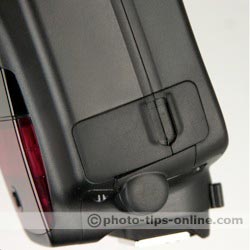 |
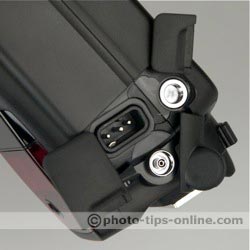 |
The menus on the LCD screen are well organized. They are probably not the very best out there but intuitive enough and pretty easy to follow (well at least for a non-matrix LCD display type). Canon managed to create a good layout for a rather complex functionality. The range bar is a nice touch - a good visual aid. The custom functions are a pain of course and all you can do is just to remember the numbers of functions you use frequently (or carry the instructions around). And once again the select dial adds a lot to ease of use.
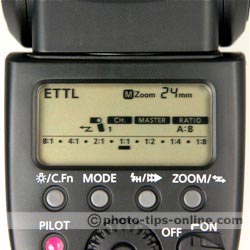 |
One thing that we don't really like is that everything on the screen starts to blink when the wide-angle diffuser is pulled out. It gives a feeling that something is wrong with the flash. We believe that this constant blinking is a bad idea and is not user friendly. They try to draw user's attention to the fact that the diffuser is out and the flash's effective range is reduced tremendously. Well, they certainly get the attention but not in the best way possible.
The Canon 580EX II comes with a pouch and an off-camera stand. The stand is plastic but seems to be durable. The pouch is very nice and provides reasonable padding. Both the flashgun and the stand fit in the pouch.
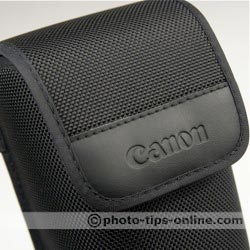 |
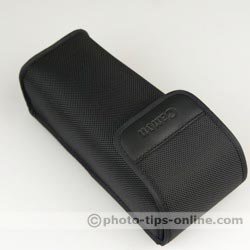 |
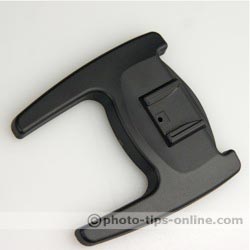 |
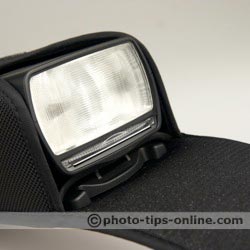 |
All-in-all the Canon Speedlite 580EX II is a very well designed unit and is a flagship of Canon's flash line. It looks and feels solid. The unit provides good and reliable exposure. It has a very good set of features, including master/slave functionality, external metering sensor (though not the very best one), PC terminal, etc. This flashgun is a clear choice for many professionals, semi-pros and, with the prices going down, even some amateurs.